Abdulla Building: Dubai's Architectural Impact

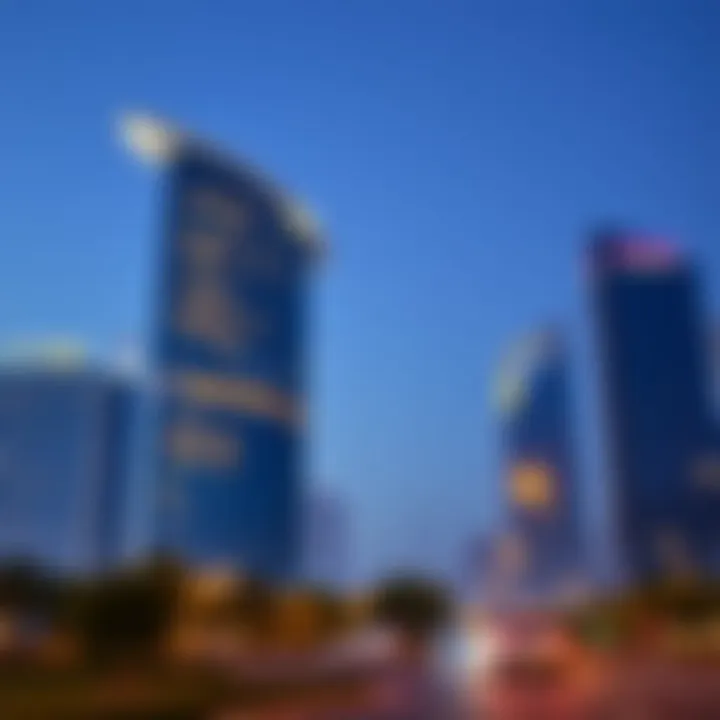
Intro
The bustling metropolis of Dubai is often hailed as a beacon of modern architecture, reflecting the city's aspirations and cultural landscape. Amidst this architectural marvel sits the Abdulla Building, a structure that, although perhaps overlooked by some, holds significant weight in the narrative of urban development and architectural significance in the region. This article embarks on a journey through the essence of the Abdulla Building, attempting to unravel its story while examining how it fits into Dubai's ever-changing skyline.
As we dissect the nuances of this structure, we will look into its design principles, the history of its construction, and the role it plays in the context of Dubai's broader real estate dynamics. We'll also touch upon its implications for future projects that promise to shape the landscape in new and unexpected ways. This investigation is not just about a building but speaks to the cyclical relationship between architecture and urban growth. By connecting these dots, we see how the fabric of the city is woven together, influencing both investors and residents alike, and setting a course for future endeavors.
Stay tuned as we delve into the intricacies of the Abdulla Building and peel back the layers that contribute to its identity and value in Dubai's architectural panorama.
Foreword to Abdulla Building
The Abdulla Building stands as a testament to Dubai's relentless evolution—a city that transforms its skyline with each passing year. This section dives deep into the heartbeat of the Abdulla Building, painting a picture of its significance not just as a mere structure, but as a cultural and architectural symbol. Understanding its relevance allows investors, property managers, and buyers to grasp the broader implications of engaging with such a landmark.
In recent years, the architectural landscape of Dubai has attracted a global audience, with structures representing cutting-edge design and innovation. The Abdulla Building is no exception; it encapsulates the ethos of modern urban architecture while grounding itself in the rich history of the emirate. This exploration brings to light aspects like its architectural choices, the socio-economic factors influencing its design, and its role in shaping not just the skyline, but the community around it. Moreover, identifying the unique characteristics of the Abdulla Building provides an avenue for upcoming investors and property managers to understand its investment potential fully.
This introduction paves the way for examining the historical context that shaped the Abdulla Building, delving into how the fusion of traditional and modern architectural elements creates a unique story. Furthermore, we will uncover the architectural overview, analyzing the design principles that guided its creation, which have propelled Dubai into the future while honoring its past.
Historical Context
To appreciate the significance of the Abdulla Building, it is crucial to consider the historical backdrop of Dubai. The emirate's evolution from a modest trading port to a bustling metropolis is nothing short of remarkable.
- Traditions and Customs: While progress is evident, the core cultural values that underpin Dubai’s character are reflected in its architecture. The Abdulla Building’s design narrative includes both contemporary and traditional influences, showcasing the emirate's respect for its heritage.
- Economic Factors: As a pillar of Dubai’s economic boom, the building's inception came at a time when the city was expanding its horizons. The late 20th and early 21st centuries saw significant investments in real estate, much of which was driven by a surge in tourism and international business.
- Urban Planning: The city’s evolution has been guided by strategic plans which have turned formerly unremarkable areas into urban centers. The Abdulla Building often acts as a focal point for urban planning initiatives that consider both community needs and aesthetic value.
This historical context enables us to see the Abdulla Building not as an isolated structure but as a pivotal chapter in a larger narrative of growth and ambition. It invites further discussion on architectural overview.
Architectural Overview
The architectural design of the Abdulla Building signifies a crucial evolution in Dubai's approach to construction—blending modern engineering with aesthetic finesse.
- Design Elements: The building exhibits contemporary lines and innovative shapes that stand out amidst an array of older structures. Its glass façade reflects the sun's rays brilliantly, symbolizing transparency and openness in both business and social contexts.
- Functional Layout: The design isn’t just about looks; it caters to functionality. With spacious layouts and modern amenities, it attracts investors looking for both commercial and residential opportunities. This duality in purpose enhances its value in a competitive market.
- Integration with Environment: Local climate and culture greatly influenced the building's design choices. Features like overhanging roofs and shaded walkways help mitigate the effects of Dubai’s scorching heat, demonstrating a thoughtful approach to sustainability.
In this architectural overview, we capture the essence of the Abdulla Building, not just as a series of walls and windows, but as a manifestation of Dubai’s spirit—forward-looking yet deeply respectful of its roots. The proceeding sections will explore further dimensions including the location, construction, and cultural implications that underscore its lasting impact in Dubai's urban landscape.
Location and Accessibility
The location and accessibility of Abdulla Building play a crucial role in its overall significance within Dubai's architectural landscape. This aspect is not merely about geographical placement but also encompasses how well the building connects with its surroundings, influencing both functionality and desirability. The strategic location can greatly enhance property value, making it an essential consideration for investors, buyers, and property managers alike. A well-connected building attracts foot traffic, enhances community engagement, and can significantly impact the local economy.
Geographic Position
Abdulla Building is strategically nestled in a vibrant area of Dubai, making it a prime spot that attracts potential tenants and businesses. Being situated near significant landmarks and residential neighborhoods, the geographic positioning provides not only aesthetic appeal but also practical advantages.
The vicinity to major commercial hubs like the Dubai Mall and Burj Khalifa ensures that the building does not exist in isolation. Instead, it thrives in a bustling environment where foot traffic is a natural occurrence. This proximity creates an innate synergy between Abdulla Building and its neighboring establishments, fostering a bustling commercial ecosystem.
Additionally, with sleek arterial roads leading directly to the building, accessibility is significantly enhanced. Those living or working nearby can seamlessly travel without the hassle of long commutes. This connectivity can turn a simple visit into a spontaneous outting, creating more opportunities for interactions—be it for business or leisure.
Transport Links
Transport connectivity is another cornerstone in the narrative of Abdulla Building. The presence of efficient public transport links, such as the Dubai Metro, towards the building serves a dual purpose: it simplifies the daily commute for employees and enhances overall accessibility for visitors. Close proximity to major transit routes is a game changer, especially in a busy metropolis like Dubai.
- Metro Stations: Several metro stations are within walking distance, which allows easy access to various parts of the city without the need for personal vehicles. This fosters a culture of using public transport, decreasing congestion and alleviating parking woes.
- Bus Services: The availability of bus services complements the metro, providing alternative paths for commuters and promoting sustainability practices. Regular services into the area mean that even those without cars can easily visit and utilize the amenities surrounding Abdulla Building.
- Cycling Paths: The city's ongoing commitment to become more bike-friendly has seen the introduction of cycling paths that lead to the building. This initiative can encourage health consciousness among the public while contributing to a reduction in carbon emissions.
In summary, the location and transport links surrounding Abdulla Building ensure that it is not only architecturally significant but also contextually vital to the ever-evolving landscape of Dubai. For investors and property managers, understanding these logistical advantages becomes a pivotal aspect in gauging the building's potential in the competitive real estate market.
Architectural Design
The architectural design of the Abdulla Building stands as a pivotal element in understanding its role within Dubai’s vibrant landscape. Architecture is not just about aesthetics; it's the language of space, the rhythm of interaction, and a dialogue between the past and present. The design of Abdulla Building captures the essence of Dubai’s ambition as a thriving metropolis, marked by innovation and bold vision.
Design Philosophy
The design philosophy behind Abdulla Building encapsulates a blend of modernism and cultural nuances. It strives to harmonize functionality with beauty. Each line and curve in the structure reflects a thoughtful consideration of its environment, the climate, and the diverse community it serves.
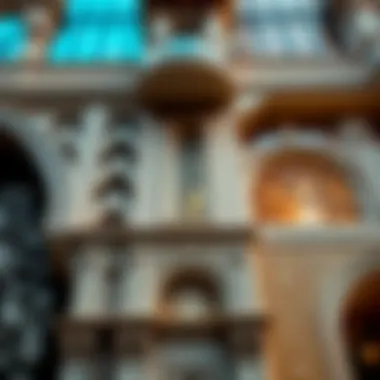
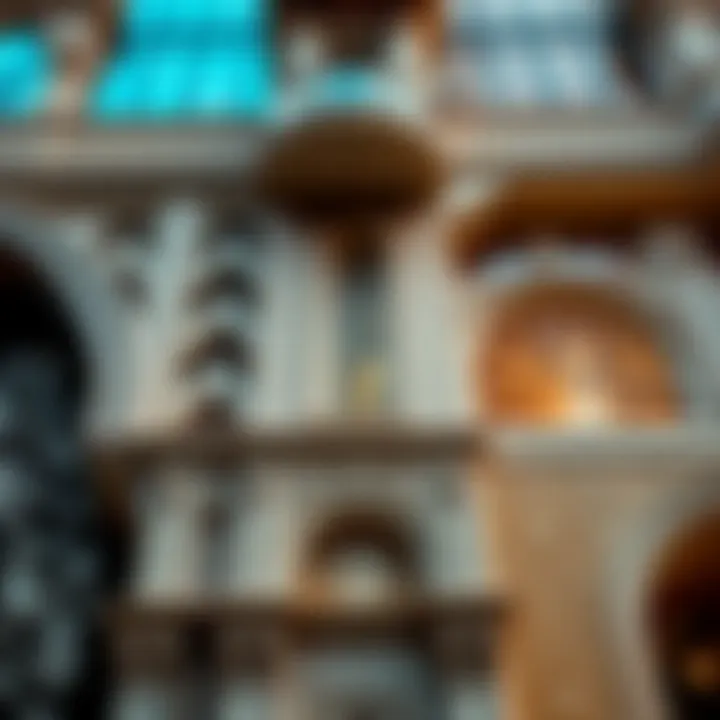
Form follows function is a principle deeply ingrained in the planning process. The building is designed not only to be pleasing to the eye but also to serve its occupants effectively. Spaces are optimized for utility, ensuring that commercial and residential areas blend seamlessly. The designers embraced open layouts, allowing natural light to flow freely, which enhances the ambiance of the interiors and reduces reliance on artificial lighting.
Materials and Techniques
Sustainability Considerations
A standout feature of Abdulla Building is its commitment to sustainability, which ties into broader urban goals. The use of eco-friendly materials such as recycled steel and low-VOC paints aids in lowering the carbon footprint of construction. Sustainability isn't just a passing fad but the backbone of modern architectural practices. That’s why it’s become a preferred choice for not only architects but also builders aiming to achieve LEED certification or similar accolades.
One unique feature is the incorporation of solar panels on the roof. These panels generate energy that significantly decreases the building's reliance on the power grid. Not only does this cut down on operational costs, but it also promotes a cleaner environment for future generations. However, implementing such sustainable techniques can initially inflate construction costs, albeit with long-term savings and energy efficiencies as a counterbalance.
Innovative Construction Methods
Innovative construction methods utilized in the making of the Abdulla Building provide another layer of depth to its architectural integrity. Techniques such as pre-fabrication and modular construction enabled quicker turnaround times. These methods are not only efficient but also reduce waste, echoing the sustainability conversation.
One of the key characteristics of these techniques is the adaptability they offer. Builders can easily modify components and designs in a fraction of the time compared to traditional methods. This flexibility fosters resilience within the structure as it adapts to needs over time.
However, with innovation comes certain challenges. For instance, the reliance on advanced materials may require specialized labor that could pose availability issues. Balancing cutting-edge techniques with traditional craftsmanship remains crucial, ensuring the building embodies both modernity and durability.
"The mix of innovative methods and sustainable practices in the Abdulla Building sets it apart as a forward-thinking structure, contributing significantly to Dubai's architectural identity."
Through these comprehensive approaches in design philosophy, materials, and construction techniques, the Abdulla Building emerges as not just a building but as a landmark echoing the aspirations of Dubai. It demonstrates how thoughtful architectural design can transform a city, offering lessons and insights for investors, property managers, and urban planners alike.
Construction Timeline
Understanding the construction timeline of the Abdulla Building is crucial for recognizing its significance and the strategic planning involved in crafting such a monumental edifice. This timeline provides insight into the various stages of development, including planning, design, and the actual building phase. Analyzing this timeline allows stakeholders—investors, property managers, or prospective buyers—to gauge the investment potential and overall value of the property within the context of Dubai's ever-growing skyline.
Planning Stage
The planning stage serves as the bedrock of any construction project. For the Abdulla Building, this phase was marked by extensive research and collaboration among architects, engineers, and urban planners. Essential steps included zoning analysis, environmental assessments, and community feedback sessions. These elements contributed not only to the feasibility of the project but also ensured that the proposed design resonated with local cultural norms and aesthetics.
In this initial phase, considerations of how the Abdulla Building would fit into the existing cityscape were paramount. There were discussions about the architectural styles prevalent in surrounding districts, ensuring that the new structure would enhance, rather than detract from, the locality's character. Moreover, planning encompassed the alignment of the project with Dubai's broader urban objectives, such as sustainable development and enhancing public spaces.
Building Phase
The actual building phase culminates in visible transformation. As construction progressed, it faced numerous challenges, which were pivotal in shaping the direction of the project.
Challenges Faced
Every construction project faces its fair share of hurdles, and the Abdulla Building was no exception. Some of the most significant challenges included logistical issues, unexpected geological conditions, and stringent regulations regarding safety and quality. These challenges often caused delays but also provided opportunities to innovate. For instance, the necessity to work around these unforeseen issues led to the adoption of advanced technologies in construction management.
One of the unique features of the Abdulla Building’s construction process was its emphasis on localized sourcing of materials. This decision, while initially complicated by supply chain setbacks, ultimately fostered a stronger connection with local manufacturers. Not only did it help mitigate unforeseen issues related to transportation, but it also supported community businesses. This aspect exemplifies how challenges can be transformed into advantageous choices.
Key Milestones Achieved
The completion of key milestones during the building phase played a crucial role in driving the project forward. Among these was the laying of the foundation, which served as a symbolic marker of the building's future presence. The topping out ceremony, usually celebrated as a major achievement, was another significant milestone that highlighted collective efforts and the commitment of all stakeholders.
Furthermore, the phased completion approach allowed for portions of the building to be operational even as other areas were still under construction. This not only optimized the project timeline but also allowed early tenants to begin contributing to the local economy, showcasing the building as a functional part of Dubai’s evolving landscape before its full completion.
"Construction timelines are not just schedules; they embody the story of a building's journey from conceptual vision to a concrete reality."
In summary, the construction timeline for the Abdulla Building encompasses a rich narrative of planning intricacies and executional challenges. Each stage enriched the project, offering valuable lessons and insights for future developments. Understanding this timeline not only adds depth to the architectural appreciation of the building but also emphasizes its role in the broader urban narrative of Dubai.
Significance in Urban Development
The Abdulla Building stands as a beacon within Dubai's architectural narrative, embodying the multifaceted impact that well-planned buildings have on urban development. In a city that is constantly evolving, this structure plays a crucial role in shaping not only the skyline but also the fabric of the surrounding community. Understanding its significance thus requires a look at various elements that underline its contribution to urban dynamics.
Impact on Surrounding Area
When a new building emerges, its immediate environment is often reshaped in unexpected ways. The Abdulla Building is no exception. Positioned strategically, it enhances the aesthetic value of the surrounding area, making it a sought-after location for both businesses and residents. This improvement is not merely superficial; the presence of the Abdulla Building increases foot traffic, encouraging local commerce and bolstering the economy.
Moreover, the architectural sophistication of the building draws attention and interest, encouraging further investment in adjacent properties. This phenomenon often results in a ripple effect, leading to the revitalization of lesser-known neighborhoods. The building acts as a catalyst, leading to increased property values, promoting new construction projects, and strengthening community ties.
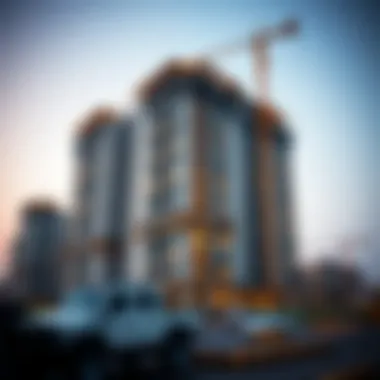
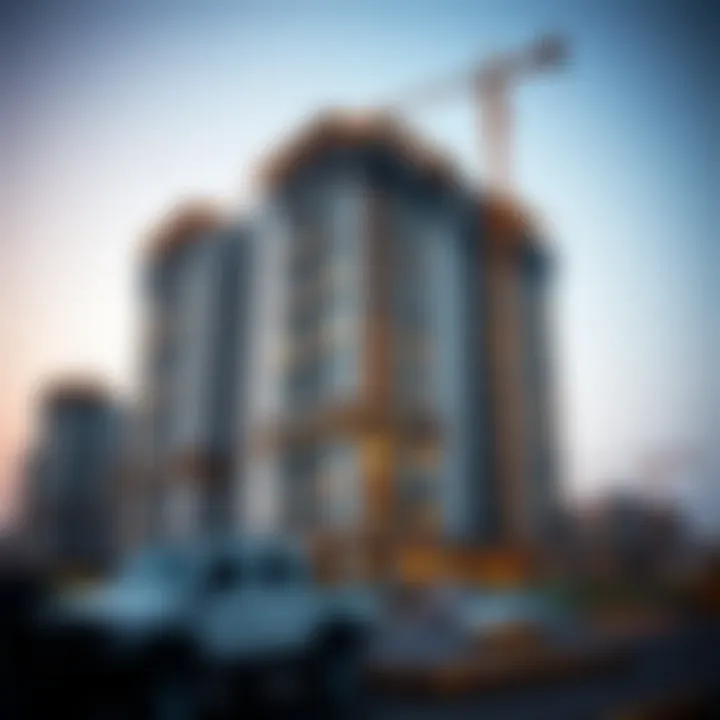
Furthermore, the building's design harmonizes with its environment, ensuring that it complements rather than overshadows its counterparts. This sensitivity to the surrounding area also contributes to maintaining a sense of identity and place, something that is especially vital in a rapidly changing city like Dubai.
Role in Cityscape
Standing tall among its peers, the Abdulla Building serves a dual purpose in the cityscape: it is both a functional space and a landmark. Its distinct silhouette has become a key feature of Dubai's skyline, representing a modern yet respectful nod to the city's rich history and diverse culture. This blend of contemporary design with local elements helps weave the structure into the larger tapestry of the city's identity.
This building creates a visual focal point, influencing how residents and visitors experience the area. It reshapes perspectives—what was once a simple view might now be accented by the impressive architecture, drawing both business and leisure traffic.
Additionally, the Abdulla Building encourages a core urban principle: density without losing livability. By integrating commercial and residential spaces, it promotes a vibrant, mixed-use environment that is essential for sustainable urban growth. It allows individuals to live, work, and play within the same vicinity, a crucial consideration for developers and urban planners alike.
"Urban development isn’t solely about constructing buildings; it’s about creating ecosystems where communities can flourish, and the Abdulla Building embodies this philosophy in Dubai."
Current Usage
The current usage of the Abdulla Building plays a critical role in understanding its broader impact on Dubai's architectural and urban landscape. It serves as both a commercial and residential hub, making it a vital component of the community it inhabits. By dissecting these elements, one can appreciate how the building's design and function contribute to the city's evolving identity.
Commercial Spaces
Within the Abdulla Building, the commercial spaces are purposefully designed to accommodate a variety of businesses. From retail shops to offices, the layout encourages interaction and movement, lending itself to a dynamic workplace environment. The strategic location contributes to foot traffic, enhancing visibility for tenants. This prime positioning often attracts startups looking for a foothold in Dubai's competitive market but also well-established firms seeking an upscale address.
Some important notes about the commercial aspect:
- Increased visibility for retail tenants due to high pedestrian traffic.
- Opportunities for networking and collaboration among businesses within the building.
- Amenities such as conference rooms available for tenants to utilize.
The commercial aspect is also enhanced by large windows that provide natural light, fostering a pleasant atmosphere for both employees and clients. The blend of aesthetics and practicality in these spaces is what makes them sought-after by prospective tenants.
Residential Units
The residential units in the Abdulla Building serve a diverse group of occupants, making it an interesting study of tenant demographics.
Tenant Demographics
The tenant demographics reflect a mix of young professionals, expatriates, and families. Young professionals are drawn in by the building's key features, such as proximity to business districts and entertainment options. This demographic often seeks trendy living spaces that allow for a work-life balance, and the Abdulla Building delivers.
One notable characteristic of these tenants is their appreciation for modern living environments that also focus on community. Amenities like a communal lounge, fitness center, and rooftop areas for socializing cater to the lifestyle choices of this group.
Market Trends
When we assess the current market trends associated with the Abdulla Building, sustainability and smart living technology play significant roles. As more people seek eco-friendly and technologically advanced homes, the building positions itself favorably. Many units feature energy-efficient appliances and smart home systems that appeal to environmentally conscious tenants.
Furthermore, the rising cost of living in Dubai has reshaped preferences, driving more individuals toward mid-range housing options as opposed to luxury accommodations. The Abdulla Building's offering of such units makes it a compelling choice for those looking to balance affordability with quality living.
In summary, the current usage of Abdulla Building highlights both its commercial viability and its appeal in the residential sector. By understanding these dynamics, investors and property managers can better navigate the intricacies of Dubai's real estate landscape.
Cultural Impact
Cultural impact goes beyond mere infrastructure; it reflects the spirit, values, and aspirations of a community. The Abdulla Building embodies Dubai's architectural and cultural evolution, fitting seamlessly into the city's fabric while standing as a testament to its heritage. It marks a critical juncture where tradition meets modernity, offering insights not only into its own design but also into the broader context of Dubai's architectural narrative.
Influence on Local Architecture
Abdulla Building has undeniably influenced local architecture, offering a modern twist to traditional designs. Its facade incorporates elements that pay homage to Islamic art, while utilizing contemporary materials and methods. This connection to heritage is vital; it allows residents and visitors alike to appreciate the architectural legacy of the region. As a prime example:
- Integration of Local Craftsmanship: The building's external details reflect local artisanship, showcasing hand-crafted features that honor traditional designs.
- Adaptive Design Elements: The rooftop gardens not only serve aesthetic purposes but also nod to traditional Emirati courtyard homes.
Such elements are crucial in promoting a unique architectural identity in Dubai, steering away from a homogenized global style.
Symbolism in Dubai's Identity
In the fast-paced environment of Dubai, structures like the Abdulla Building serve as icons of stability and permanence. They symbolize growth, ambition, and the melting pot of cultures that is Dubai today. This building stands not just as a commercial or residential vessel but as a beacon of:
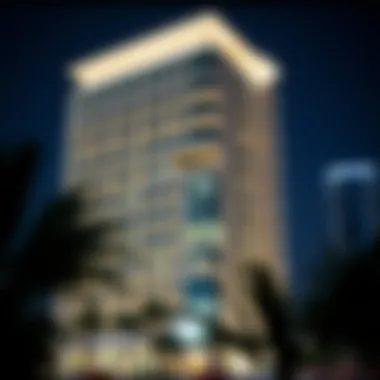
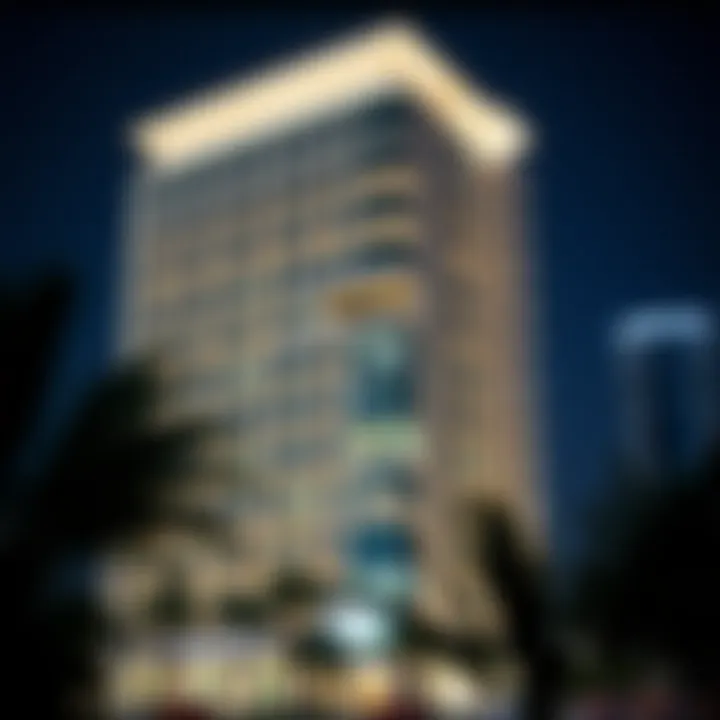
- Cultural Fusion: Its design incorporates diverse influences that symbolize the amalgamation of various cultures living harmoniously.
- Urban Evolution: As Dubai continues to expand, the Abdulla Building represents the city's aspirations and the continuous reinvention of its skyline. This is reflected in its dynamic aesthetic that resonates with both residents and tourists.
Comparative Analysis
Understanding the role of comparative analysis in analyzing Abdulla Building allows us to place it within a broader framework of notable structures not just in Dubai but across the globe. By assessing its similarities and differences against other iconic buildings, we get a fuller picture of what makes Abdulla Building unique. This section shines a spotlight on not only the design elements that echo throughout structures in urban environments but also on how functionality diverges, ultimately reflecting the grown needs of modern cities.
Abdulla Building vs. Other Notable Structures
Similarities in Design
When we peek into the design ethos of both Abdulla Building and other prominent buildings in Dubai, a common thread emerges—an emphasis on sleek aesthetics and modernity. For instance, the use of angular forms and reflective glass not only captures the sunlight but also gives a nod to the futuristic vision of the city. This architectural choice fosters a sense of openness while blurring the lines between indoor and outdoor spaces.
A key characteristic of these designs is the integration of cultural motifs. Many buildings around the world, like the Burj Khalifa, showcase local traditions through modern interpretations. Abdulla Building also borrows from Islamic geometric patterns, marrying the old with the new—an approach that appeals to investors who appreciate cultural depth in modern constructions.
The unique feature here is the incorporation of environmental considerations into design. The use of energy-efficient materials highlights sustainability as a shared goal among modern architects. This not only offers long-term financial benefits but also enhances the marketability of the property as consumers lean towards eco-conscious choices.
Differences in Functionality
In contrast to other notable edifices, Abdulla Building has a distinct purpose that sets it apart from the rest. While many skyscrapers primarily house commercial spaces, this building blends residential and corporate functions effectively, fostering a sense of community within its walls. This multifunctionality is a growing trend in urban planning, a response to the demands of city dwellers who seek convenience and accessibility—essentially, it’s a game changer in how spaces are utilized.
Another standout characteristic is its community engagement initiatives. While many similar structures might prioritize profit and aesthetics, Abdulla Building focuses on creating spaces for social interactions, like lounges and common areas, supporting the notion that urban design should enhance social connectivity.
However, this design philosophy also comes with its own challenges. For instance, balancing commercial and residential needs can lead to conflicts—a lack of harmony between noise levels, for example. Nonetheless, despite these downsides, the unique functional approach of Abdulla Building positions it as a progressive contender in Dubai's skyline.
Future Prospects
The future of the Abdulla Building holds considerable significance for its stakeholders, including investors, property managers, and potential residents. With Dubai continuing to thrive as a global hub for business, tourism, and cultural exchange, assessing the prospects for this landmark is essential for anyone looking to understand the evolving architectural landscape. As urbanization intensifies and the demand for sustainable living solutions increases, the Abdulla Building stands at the forefront of these trends, making its future developments particularly noteworthy.
Potential Developments
The potential for development around the Abdulla Building is ripe. As the city of Dubai embraces a shift towards smart cities, this structure may integrate advanced technologies that streamline operations and enhance user experience. Some expected developments include:
- Smart Technology Integration: The building could implement smart sensors to manage energy consumption effectively, providing real-time data to tenants and managers alike.
- Enhanced Green Spaces: Expansions to include rooftop gardens or landscaped communal areas could promote community engagement and improve quality of life.
- Mixed-Use Spaces: Converting underused areas into vibrant commercial zones or co-working spaces can attract diverse clientele, spurring economic growth.
These potential developments signal a forward-thinking approach that aligns with Dubai's ambitious growth plans while catering to a climate-conscious audience.
Long-term Sustainability
Long-term sustainability remains paramount for the future of the Abdulla Building. As environmental concerns dominate global discussions, embracing sustainable practices is both a necessity and a competitive advantage. Considerations include:
- Energy Efficiency: Future adaptations could aim for net-zero energy consumption through the use of renewable energy installations like solar panels or wind turbines.
- Water Conservation: Implementing advanced water recycling systems can minimize waste, and greywater systems might be utilized to maintain gardens and landscapes.
- Building Materials: Choosing sustainable materials for any renovations or expansions could reduce environmental impact and appeal to environmentally-conscious investors.
"The shift towards sustainability isn't just a trend; it's a transformation in our approach to urban living."
These sustainability efforts not only align with global environmental goals but also enhance the building's market appeal. Investors seeking future-proof assets will find that the integration of these sustainable measures can significantly bolster the intrinsic value of the Abdulla Building.
In summary, the future prospects surrounding the Abdulla Building encapsulate a blend of innovative developments and sustainable practices. Understanding these aspects will be critically important for anyone who considers involvement with this iconic structure as Dubai advances further into the 21st century.
The End
The conclusion of this article serves to encapsulate the various dimensions explored throughout the discussion regarding Abdulla Building, shedding light on its multifaceted significance within Dubai's architectural framework. This structure is not merely a series of bricks and mortar; it stands as a testament to the region's rapid urban metamorphosis, showcasing how innovative designs can contribute to enriching the cityscape.
Summary of Findings
In reviewing Abdulla Building, we discovered several pivotal elements that underscore its importance.
- Architectural Identity: The building's design elements resonate with contemporary trends while paying homage to cultural heritage. This blend not only enhances aesthetics but also fosters a sense of belonging among inhabitants and visitors alike.
- Urban Development Role: The construction and function of Abdulla Building has played a crucial role in the surrounding area's urbanization, driving investments and facilitating community growth.
- Demand for Spaces: The building attracts both commercial and residential interests, reflecting shifting market dynamics and preferences among potential buyers and tenants.
The unique design, strategic positioning, and adaptable usage underscore a broader narrative of growth within Dubai, emphasizing the city's ambitions to remain a beacon of innovation and progress.
Implications for Investors
For investors, Abdulla Building presents a wealth of opportunities.
- High Demand: With its favorable location, the building is likely to maintain sustained demand, which can translate into favorable rental yields.
- Long-Term Value: As Dubai continues to develop, properties like the Abdulla Building are positioned for potential appreciation in value, making investments here not just about current gains but also future growth.
- Cultural Significance: The building is integral to Dubai's evolving architectural identity, enhancing its cultural value which can appeal to international investors looking to diversify their portfolios.
To consider investing in the Abdulla Building, one must weigh these elements thoughtfully. Understanding its impact not just within the real estate market but also in the cultural and social fabric of Dubai is essential for making informed decisions. This analysis emphasizes the necessity for strategic foresight, ensuring that investor interests align with the broader urban narrative of sustainability and growth.



